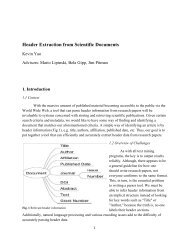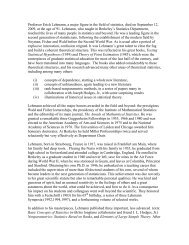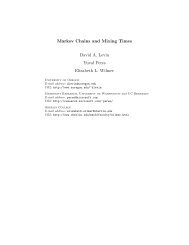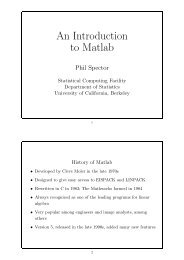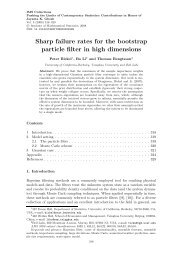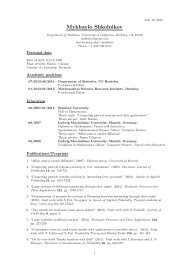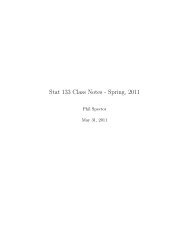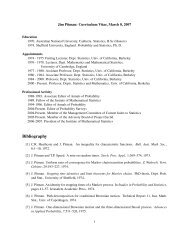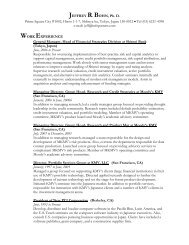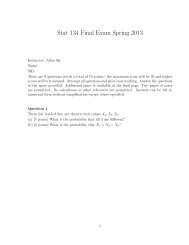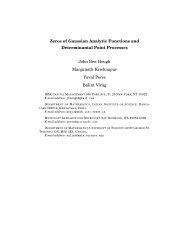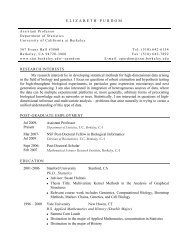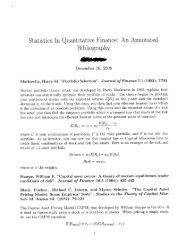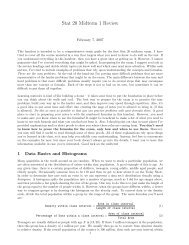Stat 215b (Spring 2005): Lab 2
Stat 215b (Spring 2005): Lab 2
Stat 215b (Spring 2005): Lab 2
Create successful ePaper yourself
Turn your PDF publications into a flip-book with our unique Google optimized e-Paper software.
<strong>Stat</strong> <strong>215b</strong> (<strong>Spring</strong> <strong>2005</strong>): <strong>Lab</strong> 2<br />
GSI: Victor Panaretos<br />
victor@stat.berkeley.edu<br />
Due Feb 15 at the <strong>Lab</strong> section<br />
In this lab we shall investigate another linear model. The data maybe found in the file lab2.txt<br />
on the class webpage. The focus for this lab will be on hypothesis testing and model selection.<br />
In particular this data relates to data from an experiment on a particular wire bonding process.<br />
The goal is to study how bond sheer strength depends on four variables of interest. A total of 30<br />
observations were made. The first column gives the dependent variable Bond Sheer Strength (S).<br />
The second through fifth give the independent variables of interest: Force (F), Ultrasonic Power<br />
(P), Temperature (T) and Time (D) in that respective order.<br />
First consider fitting a linear model relating strength to the four other variables. That is<br />
S i = β 0 + β 1 F i + β 2 P i + β 3 T i + β 4 D i + ɛ i (1)<br />
Be sure to carefully state your assumptions. Report your parameter estimates, their standard<br />
errors etc. Analyse the residuals from your fitted model, comment on how they relate to your<br />
model assumptions. How about any outliers?<br />
Consider the following three hypotheses<br />
• H 0 : The model in (1) is “correct”.<br />
• H 1 : β 4 = 0<br />
• H 2 : β 2 − β 1 = 0<br />
Carry out tests of H 0 against its complementary hypothesis, and of H 1 against H 0 and H 2 against<br />
H 0 . Be clear to state what test statistic you are using, any p-value and interpret your results. As<br />
always make clear what it is you are assuming. Note that you do not need to do the simultaneous<br />
test here, but you might want to comment on the issue. How could you answer this question in a<br />
confidence interval setting? How about in the simultaneous case?<br />
Now consider fitting a more flexible model including quadratic terms (including the “crossproduct”<br />
terms. Try to explain the advantages and drawbacks of including more parameters in the<br />
model. One method of determining a model is to use backward stepwise deletion. The procedure<br />
is basically as follows.<br />
1. Determine the terms in your model and fit using least squares<br />
2. Look at the p - values for each term. If all p values are 0.05 or less no variable deletion is<br />
required and you may stop, otherwise continue<br />
1
3. If the term with the largest p value is a quadratic or cross term remove it and go back to the<br />
first step, other wise continue<br />
4. If the term with the largest p value is a linear term delete it only if it is not involved in any<br />
quadratic or cross product terms. Otherwise look for the term with the next largest p-value<br />
and and repeat the previous step. Continue until either a term is deleted in which case return<br />
to the first step or that all p-values are 0.05 or less.<br />
Consider the suggested full model and carry out the backwards deletion. Report your final model.<br />
Test your final model from this method against your linear model from the first part of this lab,<br />
be sure to explain the test statistic you are using.<br />
Consider what might happen if you treated the measurements of the independent variables as<br />
factors rather than just numerical values. Explain why you might do this (ie what sort of evidence<br />
might you expect to see, in residuals or otherwise). What sort of drawbacks can you imagine for<br />
treating the data like this? Note that you are not required to fit the model, however if it helps your<br />
understanding go ahead and try it.<br />
2



